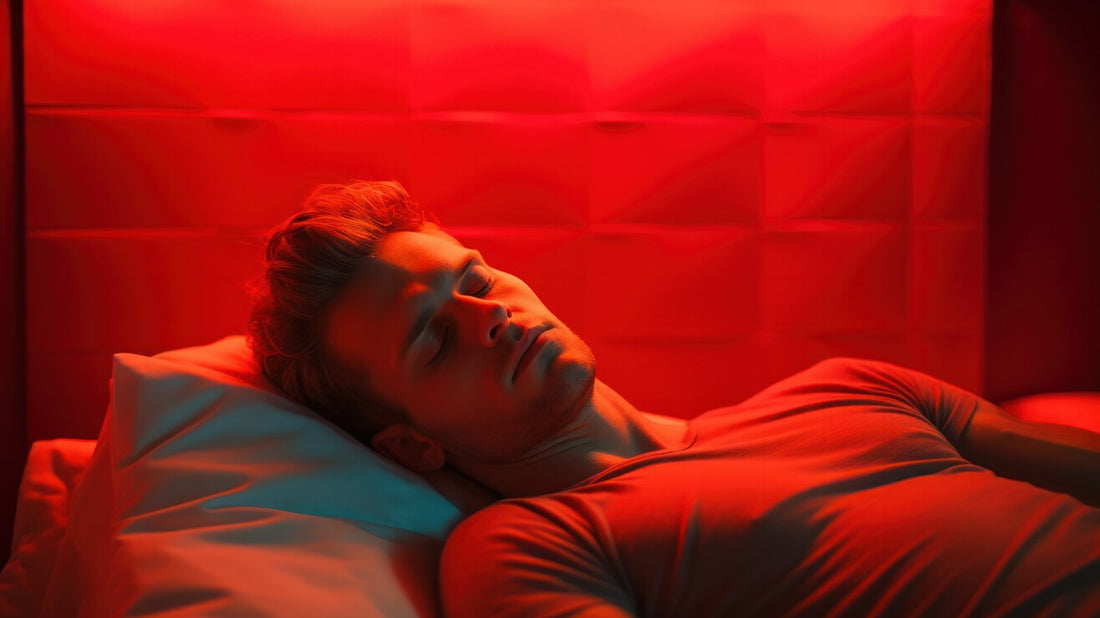Benefits of Red Light Therapy for Better Sleep
Red light therapy, also known as low-level laser therapy (LLLT) or photobiomodulation (PBM), has gained attention for its potential benefits in various areas, including sleep quality. Here's how red light therapy might contribute to better sleep:
-
Melatonin Regulation: Red light therapy may help regulate the body's production of melatonin, a hormone crucial for sleep-wake cycles. Exposure to red light in the evening or before bedtime may suppress the release of melatonin, promoting wakefulness, while exposure in the morning may help regulate the circadian rhythm, enhancing sleep quality at night.
-
Reduced Cortisol Levels: Cortisol, known as the stress hormone, can disrupt sleep patterns if elevated before a person goes to bed and sleep. Some research and studies suggest that red light therapy may help lower the levels of cortisol, promoting relaxation and better sleep quality and quantity.
-
Improved Circadian Rhythm: Our body's internal clock, or circadian rhythm, plays a very important role in regulating sleep-wake cycles. Exposure to red light, particularly in the morning or during the day, may help synchronize this circadian rhythm, making it easier to fall asleep at night and wake up feeling refreshed and rejuvenated.
-
Enhanced Relaxation: Red light therapy has been shown to promote improvement in sleep and serum melatonin production, thereby increasing relaxation through stimulated production of endorphins and reducing muscle tension. Relaxation before bedtime can facilitate the transition to sleep and improve overall sleep quality.
-
Reduction of Sleep Disorders: Some studies and research on red light therapy suggest that it may be beneficial for individuals with sleep disorders such as insomnia or sleep apnea. By promoting relaxation, reducing inflammation, and improving blood flow, red light could potentially alleviate symptoms associated with these conditions and improve sleep quality.
-
Increased Deep Sleep: Deep sleep, also known as slow-wave sleep, is essential for physical and mental restoration. Red light therapy may help increase the duration and quality of deep sleep, leading to more restorative rest and better overall sleep quality.
It's important to note that while there's promising evidence supporting the potential benefits of red light to help you sleep, more research is needed to fully understand its mechanisms and effectiveness. Additionally, individual responses to the therapy may vary, and it's essential to consult with a healthcare professional before starting any new treatment, especially if you have underlying health conditions or are taking medications.
Red Light and Sleep: How Does Red Light Affect Sleep Quality?
Red light can have both positive and negative effects on sleep quality, depending on various factors such as timing, intensity, and individual differences. Here's how red light can impact sleep:
-
Melatonin Suppression: Exposure to any type of bright light can suppress sleep and serum melatonin production, a hormone that regulates sleep-wake cycles. Melatonin suppression can make it harder to fall asleep and reduce overall sleep quality. However, compared to blue light, red light has a lesser effect on melatonin suppression.
-
Circadian Rhythm Regulation: Red light exposure can help regulate the circadian rhythm when used appropriately. Light exposure, particularly in the morning or during the day, can signal to your body that it's time to be awake and alert, thereby preventing sleep inertia upon waking or still feeling sleepy after waking up. Conversely, exposure to LED lights like blue lights and red lights in the evening or before bedtime can signal the body that it's time to wind down and prepare for sleep.
-
Reduced Blue Light Exposure: Using red light as an alternative to blue light sources in the evening can be beneficial for sleep. Blue light, which is emitted by electronic devices like smartphones and computers, is known to disrupt sleep by suppressing melatonin production and interfering with circadian rhythms. By reducing exposure to blue light and replacing it with red light, you can potentially improve your sleep quality.
-
Shift Work and Sleep Disorders: For individuals who work night shifts or have irregular sleep schedules, exposure to red light spectrum during nighttime hours might help mitigate the negative effects of artificial light on sleep. Red light is less likely to disrupt circadian rhythms compared to blue or white light, making it a potentially useful tool for managing sleep in these populations.
-
Individual Variations: It's important to recognize that individuals may respond differently to red light exposure. While some people may find red light soothing and conducive to sleep, others may not experience any noticeable benefits. Additionally, factors such as age, genetics, and pre-existing sleep disorders can influence how red light affects sleep quality for different individuals.
Overall, incorporating red light in the evening and minimizing exposure to blue light from electronic devices can be a part of a healthy sleep hygiene routine. However, it's essential to consider individual differences and consult with a healthcare professional if you have concerns about your sleep quality or patterns.
Sleep Disorders that Red Light Therapy Devices Can Improve
Red light, also known as photobiomodulation (PBM), has been shown to improve sleep problems by influencing biological processes such as circadian rhythm regulation, melatonin production, and neural activity. While more research is needed to fully understand its efficacy and mechanisms of action, some sleep disorders and sleep deprivation problems that red light devices may help improve include:
-
Insomnia: Devices emitting red light wavelengths have been studied for their potential to improve insomnia, a condition characterized by difficulty falling asleep or staying asleep. By promoting relaxation and reducing stress, redlight treatment may help individuals with insomnia achieve better sleep quality and duration.
-
Delayed Sleep Phase Syndrome (DSPS): Delayed Sleep Phase Syndrome (DSPS) is a circadian rhythm sleep disorder characterized by a significant delay in the timing of the sleep-wake cycle relative to conventional or socially acceptable times. Individuals with DSPS typically have difficulty falling asleep at a desired bedtime and struggle to wake up in the morning, often leading to daytime sleepiness and impaired functioning. This is due to poor quality of sleep and serum melatonin levels.
-
Shift Work Sleep Disorder: Shift work disrupts the body's natural circadian rhythm, leading to sleep disturbances and excessive daytime sleepiness. Red light, particularly when used strategically to simulate natural light exposure during shift work hours, may help regulate the circadian rhythm and improve sleep quality and alertness among shift workers.
-
Jet Lag: Jet lag occurs when traveling across multiple time zones, resulting in the desynchronization of the body's internal clock with the new time zone, which in turn interferes with sleep. Red-light therapy, especially when used in combination with other strategies such as light exposure and melatonin supplementation, may help alleviate symptoms of jet lag by resetting the circadian rhythm more quickly and thus giving a person quality sleep.
-
Sleep Disruption in Aging: Older adults often experience changes in sleep patterns, including reduced sleep efficiency and increased wakefulness during the night. Red light has been investigated as a potential intervention to improve sleep quality and duration in older adults by supporting the natural processes involved in sleep regulation.
-
Sleep Disturbances in Neurological Disorders: Red light has shown promise in improving sleep disturbances associated with neurological disorders such as Parkinson's disease, Alzheimer's disease, and traumatic brain injury. By modulating neural activity and promoting neuroprotection, red light may help regulate sleep patterns in individuals with these conditions.
-
Sleep Disturbances in Mental Health Disorders: Individuals with mental health disorders such as depression and anxiety often experience sleep disturbances as a symptom of their condition. Red light may help alleviate sleep disturbances in these individuals by reducing symptoms of depression and anxiety and promoting relaxation.
While red light shows potential for improving various sleep disorders, it's essential to note that individual responses may vary, and more research is needed to establish its efficacy and optimal protocols for different sleep conditions. Additionally, red light therapy should be used as part of a comprehensive treatment plan, and individuals with sleep disorders should consult with a healthcare professional for personalized recommendations.
Side Effects of Using Red Light Therapy for Sleep
Red lighyt, also known as photobiomodulation (PBM), has gained attention for its potential benefits in various health applications, including improving sleep. However, like any therapeutic modality, there can be side effects associated with its use. Here are some potential side effects to consider when using red light treatment for sleep:
-
Skin Irritation: While red light treatment is generally considered safe, some individuals may experience skin irritation or sensitivity, especially if they have pre-existing skin conditions or are using high-intensity light bulbs and devices. This could manifest as redness, itching, or a rash at the site of treatment.
-
Eye Strain: Direct exposure of the eyes to red light has been shown to cause eye strain or discomfort. It's important to use appropriate eye protection, such as goggles or glasses specifically designed for use with red light treatment devices, to minimize the risk of eye damage or discomfort.
-
Disruption of Circadian Rhythm: Irradiation from a red-light therapy may also affect the body's circadian rhythm, which regulates the sleep-wake cycle. While exposure to light in the evening may promote sleep by increasing melatonin production, exposure to bright light in the morning or during the day is essential for maintaining a healthy circadian rhythm. Using this treatment at the wrong time of day could potentially disrupt sleep patterns.
-
Headaches or Dizziness: Some individuals may experience headaches or dizziness as a side effect of exposure to the wavelength of light, especially if the intensity or duration of exposure is too high. It's important to start with low-intensity treatments and gradually increase the duration and intensity as tolerated to minimize the risk of adverse effects.
-
Interference with Medications or Medical Conditions: Some experts found that red light may also affect and interact with certain medications or medical conditions, potentially exacerbating existing health issues or interfering with the effectiveness of medications. It's essential to consult with a healthcare professional before starting the treatment, especially if you have any underlying medical conditions or are taking medications.
-
Heat Sensitivity: Red light devices can generate heat, especially with prolonged use or high-intensity settings. Individuals who are sensitive to heat may experience discomfort or exacerbation of symptoms with red light.
-
Overstimulation: Excessive or prolonged exposure to red light may lead to overstimulation of tissues or cells, potentially causing unintended physiological effects. It's essential to follow recommended guidelines for treatment duration and intensity to avoid overstimulation.
Overall, red light treatment is considered safe for most individuals when used appropriately, but it's essential to be aware of potential side effects and consult with a healthcare professional if you have any concerns or experience adverse reactions. Additionally, it's crucial to use high-quality devices and follow manufacturer instructions carefully to minimize the risk of side effects.
Sources:

